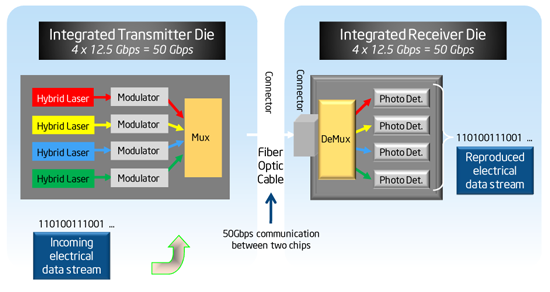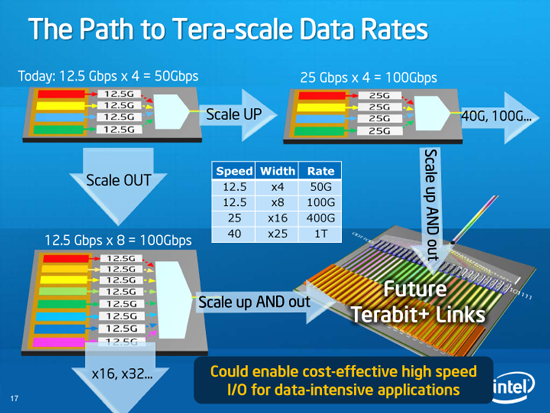Intel's 50Gbps Silicon Photonics Link: The Future of Interfaces
by Brian Klug on July 30, 2010 6:49 AM EST- Posted in
- Trade Shows
- Intel
- Photonics
- Laser
Scaling up (bitrate) and out (WDM)
Intel demonstrated an effective speed of 12.5 gigabits/s per wavelength. Using wavelength division multiplexing (WDM), one can increase the number of wavelengths (or channels) in the fiber, effectively adding more bandwidth. Intel calls this 'scaling out.' This is what’s done in virtually every long haul fiber optic telecommunications network. Even though each wavelength in conventional teleco systems might only be 10 or 20 gigabits/s, the fiber itself can carry many wavelengths, resulting in much higher aggregate bandwidth for a single fiber.

Wavelength Division Multiplexing (WDM)
One can also increase the bitrate of each channel, intel calls this 'scaling up.'

Intel’s demonstration is effectively a vastly miniaturized end to end fiber optic telecommunications system. Instead of cities, you’ve got CPUs and ICHs. Instead of a rack of modulators and optical multiplexers, you’ve got one chip on both ends. The links between components are inevitably going optical, the same way growing need for more and more bandwidth drove almost all terrestrial communications into fiber optic networks.
Both this 50G silicon photonics link and Light Peak are at the core of Intel’s overall I/O strategy for the future, one where copper data links are supplanted almost entirely by optical fibers. No doubt copper will still live on - one still needs to bring power to devices - but in a reduced capacity.
Light Peak is what Intel is calling its first consumer implementation of an external optical bus, and will start at 10 gigabits per second, and will start appearing in products sometime in 2010. The bus will support multiple protocols as well - in theory, you could send USB, ethernet, audio, and video at super fast rates over one unified optical connection. If you think about the same thing happening but on the motherboard, you’ll get a sense for the beginning of how optical data connections will supplant copper.
Hopefully some day we’ll be talking about replacing electrons in microprocessors with photons, and computing entirely with light. Optical computing poses a host of challenges before it can be fully realized, but eventually Intel might replace ICs with photonic equivalents entirely. That future is still decades away, but until then we’ll definitely be using optical busses for moving data around.










42 Comments
View All Comments
GullLars - Wednesday, August 4, 2010 - link
Go liquid cooling, and you can get 500-2000W worth of power as densely packed as an ITX card. By using optical connections to build in 3D, you can have multiple planes of components.nafhan - Friday, July 30, 2010 - link
Another problem with motherboard design that this will help with is RF interferance.nafhan - Friday, July 30, 2010 - link
For anyone with a radio background, if the term WDM seems odd it's the term used by fiber optic people for FDM.Also, like to emphasize how big of an advantage that photonics/fiber optics have over normal electrical signals in motherboard design or any other application with a high frequency electrical signal. Replacing electrical signals with something that has essentially no radiated signal is huge. No interference is a very good thing.
This stuff is just cool...
spunlex - Friday, July 30, 2010 - link
<quote> it emits primarily phonons (lattice vibrations - and through a ton of hand waving and thermodynamic processes, heat), and very few electrons. </quote>I think this should read "and very few <b>photons</b>."
Great article, it's good to see manufacturing of cheap quality lazers really took of in the past couple year. I am looking forward to many more interesting articles on photonics.
spunlex - Friday, July 30, 2010 - link
I totally forgot these comments don't support formating, still pining for the edit feature.Brian Klug - Friday, July 30, 2010 - link
Oh wow good catch! That's what I get for writing this so late at night!-Brian
spunlex - Friday, July 30, 2010 - link
I know what you mean, no where near as bad as some of the late night lab reports I have handed in.iwodo - Friday, July 30, 2010 - link
It mean we finally have VERY Good On broad Audio Chipset,GDILord - Monday, August 2, 2010 - link
Well, what exactly do broads have right now? :-)cesthree - Saturday, July 31, 2010 - link
When can we get this for an external GPU case?Have a case that only houses GPU's with their own PSU's and cooling solutions.
Connect that case with your case via a Photon Link. I can't begin to list the advantages of a setup like this.
I'm sure there is disadvantages. I know I would buy/make one if I could.